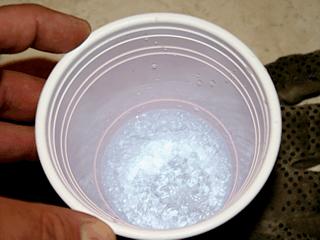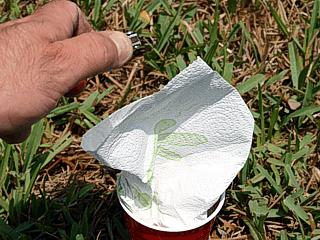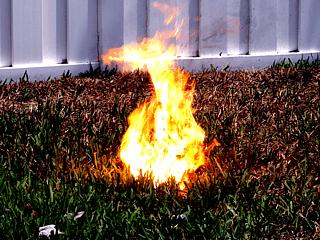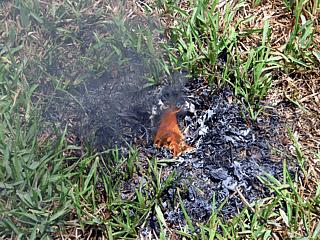

| This area shows my work with tesla coils as well as other "cool" and intriguing science experiments. First of all, my "weird" science section mainly is toward my work with Tesla coils. A tesla coil is an ultra-high voltage science project using a high voltage primary power supply, a capacitor matched to a primary coil of heavy guage wire, a spark gap, and a secondary of many turns of thin wire. A tesla coil, in electrical engineering terms, is both a high frequency RC (resistor and capacitor) oscillator and an air core transformer. The combination of the high voltage power supply (such as a neon sign transformer), the capacitor, and primary coil form the RC circuit. The spark gap, produces spikes in the voltage, and triggers many harmonics (multiples of the 60 Hz input frequency) that are enhanced by the RC circuit. The primary coil, wrapping around the secondary coil, produces an intense high frequency magnetic field that induces a high frequency current in the secondary coil, even though air separating the two. Such frequencies are in the RF (radio freqnency) range and can be from 100 to 500 kHz. Output voltages can be in the tens (or even hundreds) of thousands of volts, or more! Tesla coils are not difficult to construct, as a matter of fact, nearly all their components can be found at the local hardware store and are inexpensive. Anyone with a good understanding of electronics can construct such a device. This interesting page shows my work in this exiting area of electronics. DANGER - Tesla coils involve extremely high voltages and their construction / use requires a thorough understanding and respect for electricity. The voltages and equipment described in their section are not toys. Carelessness and lack of knowledge with such high voltage applications CAN KILL YOU!! I assume no responsibility for anyone who gets hurt from attempting or using any technique or device displayed in this section. Two rules of thumb, if you don't know what you are doing, don't do it! Plus, when making adjustments, any electrical adjustments, unplug it!! The tesla coil project is aimed mainly at the scientific and tesla coiler community. I intend to use my tesla coil for lightning demonstrations and entertainment. Other pictures and resources to interesting and / or unique scientific experiments are also portrayed on this page, also called "Weird Science"! Note - This page may take a while to load on some SLOWER connections! |
 Tesla Coil Project Video Clip
Tesla Coil Project Video Clip Air Gun Video Demonstration
Air Gun Video Demonstration
 First Tesla Coil - Part One
First Tesla Coil - Part One
 Second Tesla Coil Attempt - Part Two
Second Tesla Coil Attempt - Part Two
 Finished Coil - Part Three
Finished Coil - Part Three
 Functional Tesla Coil - Part Four
Functional Tesla Coil - Part Four
 Dual Tesla Coil - Part Five
Dual Tesla Coil - Part Five
 Big Tesla Coil - Part Six
Big Tesla Coil - Part Six
 Table-Top Tesla Coil - Part Seven
Table-Top Tesla Coil - Part Seven
 High-Power Tesla Coil - Part Eight
High-Power Tesla Coil - Part Eight
Liquid oxygen (or LOX) is a cryogenic liquid for of oxygen and is extremely cold at about -298 degrees below zero farenheit (-193 celsius). It is a pale blue
liquid and accelerates combustion violently because it offers roughly 4,000 times the available oxygen in the air we breath. It has many uses, from medical
supplies (for oxygen therapy) to rocket fuel oxidizers. LOX is dangerous because of two reasons, first of all, it is extremely cold, and can freeze anything on
contact. Second, it accelerates combustion rather quickly, how quickly? You will see a demonstation of this in this section! Here I will fill a normal plastic
party cup about 1/3 full of LOX from a medical supply Dewar of LOX. I will then place a piece of paper towel in the cup, place it in an open area of grass, light
the paper with a cigarette lighter, and get away!

|
This is a picture of the plastic cup filled about 1/3 with liquid oxygen. As you can see, the LOX is pale blue in color and bubbling since the room temperature rapidly causes the liquid to boil off into oxygen gas, which is colorless. |

|
Here is the same cup, with a piece of paper towel in it, being lit with a cigarette lighter (carefully!) and placed in an open area in the grass. Now it is time to get away quickly and watch from roughly 30 feet away. |

|
The flame burns the top of the paper towel normally, and continues downward until reaching the LOX soaked portion of it at the bottom of the cup. The LOX, providing nearly 4,000 times the oxygen to the burning paper towel that air would, bursts into a violent and brilliant yellow flame. The paper towel along with the entire plastic cup is also consumed in about 3 seconds with a distinct "whoosing" sound. |

|
Here is what is left afterwards. The cup and paper towel is completely gone! The intense heat of the reaction that just took place also creates a large burn mark in the grass. This is why LOX is so dangerous around anything combustible. Don't smoke around LOX either. |
This section has been dedicated to my first attempt at building an "air cannon" (pneumatic gun). This is basically a launching device built out of PVC
piping so that pressurized air can force (or shoot) a projectile at high velocities. The cannon is constructed of three basic parts: an air reservoir (tank),
a valve (trigger), and acceleration tube (gun barrel). The main air tank is a 36" section of 2 1/2" PVC tubing with a bushing at each end with a "T" connector
and another bushing near one end. The "T" bushing connects to 3/4" PVC tubing which leads to a ball valve. From the ball valve, the PVC tube curves around
and mates with the end of a 62" long section of 1/2" PVC, which passes through the air chamber (tank) via the two sealing bushings at each end. A tire valve
in the 3/4" PVC tube between the air reservoir and ball valve allows the cannon to be "charged" with pressure simply by closing the ball valve, filling the
tank with up to 100 PSI of air then loading the barrel with a projectile, such as a wire-cap, marble, wood dowel, etc. Aim the cannon at a target away from
people and property, and quickly release the ball valve. The decompression fires the "bullet" down the barrel with a loud bang and into the air at the
target.
HTML File "tesla.htm" - Developed By Chris Collura
To Return To The HOME Page Of This Site Click The "INDEX.HTM" Link Here!